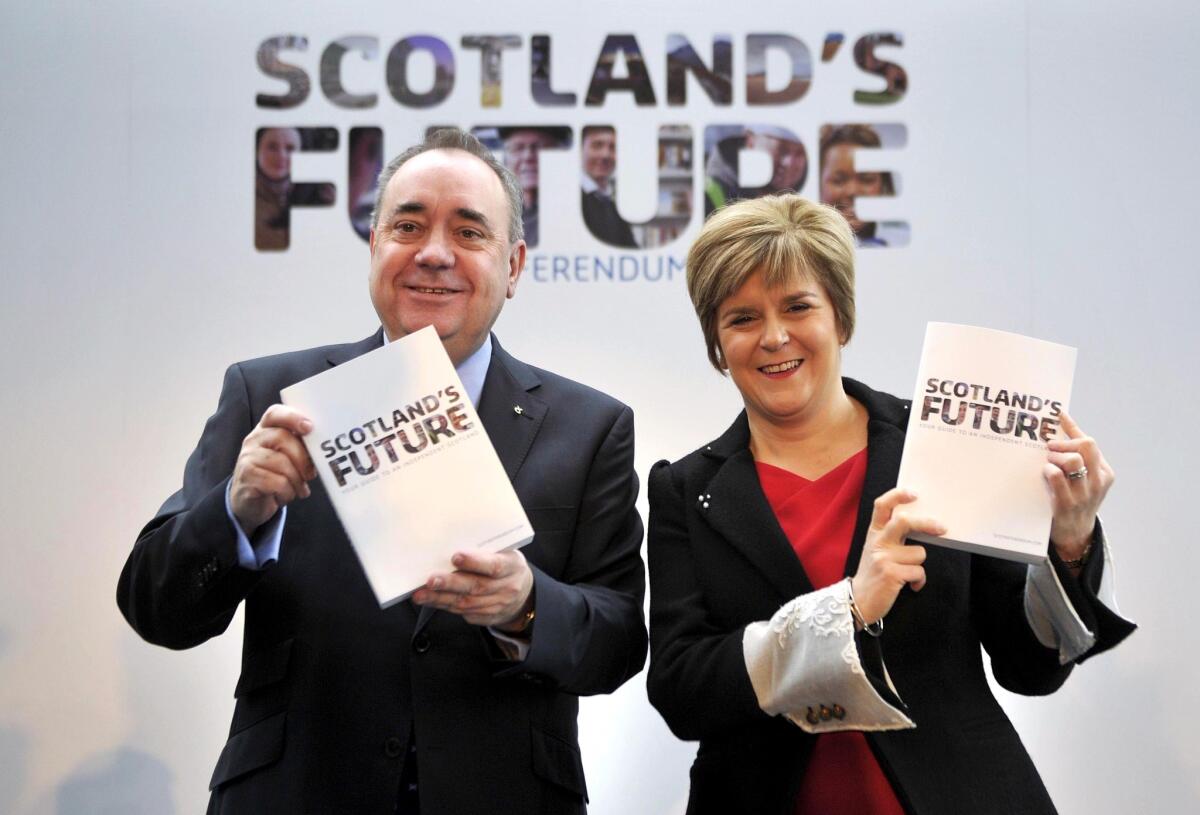Scottish government outlines case for independence

- Share via
LONDON -- An independent Scotland would be richer, fairer and nuclear-free but would keep the British pound, the queen and membership in the European Union, the Scottish government pledged Tuesday, laying out its most comprehensive blueprint for secession from Britain.
With less than a year before Scotland votes on whether to seek a divorce from England and Wales, campaigners for the “Yes” side released a nearly-700-page document outlining the practicalities and priorities of independence, addressing everything from currency arrangements to the provision of free child care for families of all preschoolers.
But the manifesto immediately came under attack as little more than a wish list whose most important elements are by no means guaranteed. Opponents accused Scottish officials of evading tough questions and of misleading voters about the obstacles Scotland would face as an independent nation of 5 million people.
Next September’s referendum puts the political map of Britain to its biggest test since Ireland broke away from the British crown nearly 100 years ago. A victory for Scottish nationalists would end more than three centuries of their being yoked to their brethren south of the border.
Alex Salmond, first minister of Scotland’s semi-autonomous government and leader of the Scottish National Party, said that the calculus was simple.
“Ultimately, at the heart of this debate, there’s only one question and one choice: Do we the people who live and work in Scotland believe that we are the best people to take the big decisions about our future?” Salmond told a news conference in Glasgow. “It’ll be decided by the people. Scotland’s future is now in Scotland’s hands.”
An independent Scotland could pursue its own vision of a just society without interference from London, including the expulsion of British nuclear submarines from Scottish waters, greater investment in children and better social services, Salmond said. Being part of Britain has cost Scots their fair share of revenue from North Sea oil, which independence would allow them to reclaim, he said.
“An independent Scotland would start from a position of strength,” Salmond said. “In fact, we’d become independent in more promising circumstances than virtually any other nation in history.”
But that rosy view has been challenged not just by Salmond’s political foes but by a respected nonpartisan think tank, which last week warned that an independent Scotland would immediately face drastic spending cuts and tax increases to bring down its deficit. An aging population and declining oil revenues would add to the pressure on an independent Scottish government, it said.
Anti-independence activists also contend that key promises by the “Yes” campaign are far from assured. Officials in London have begun warning Scotland not to take for granted that it could continue to use the British pound, and even if it did, critics say, the Scottish government would have no control over the money supply and interest rates, making for a paltry sort of sovereignty.
“They’ve ducked all the big questions, the fundamental questions, like how can they guarantee the pound,” former Chancellor of the Exchequer Alistair Darling, who is leading the “No” campaign, told the BBC. “What’s Plan B if they can’t get that?”
Opinion polls in Scotland have never shown a majority in favor of outright independence, though many Scots want more autonomy. Salmond’s party had originally pushed for the referendum to include an alternative option granting his government greater powers, but the Sept. 18, 2014, plebiscite will allow only a yes-no vote on whether Scotland should go it alone.
ALSO:
Ruling party’s lead disputed in Honduran presidential election
Philippines typhoon: U.S. aid efforts begin focusing on recovery
Afghan president defies U.S. on security pact, adds new demands
More to Read
Sign up for Essential California
The most important California stories and recommendations in your inbox every morning.
You may occasionally receive promotional content from the Los Angeles Times.











